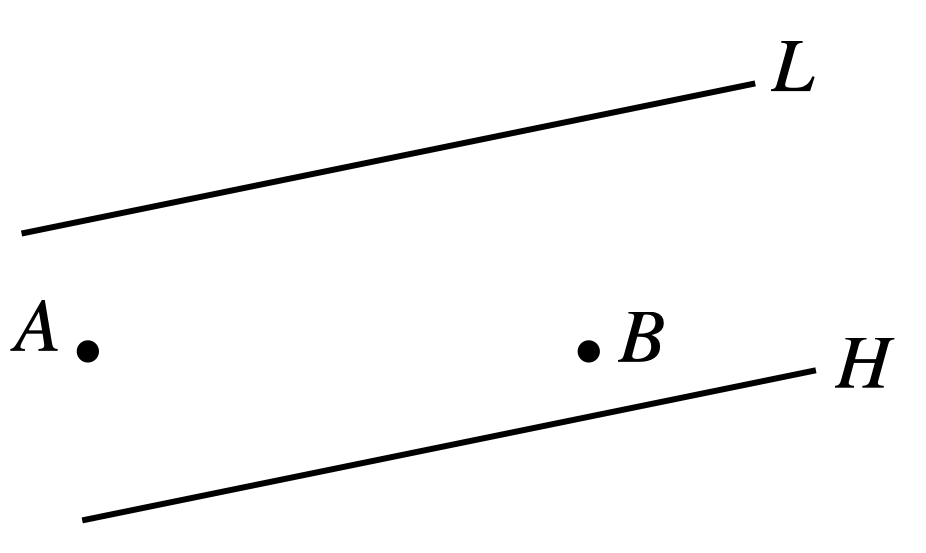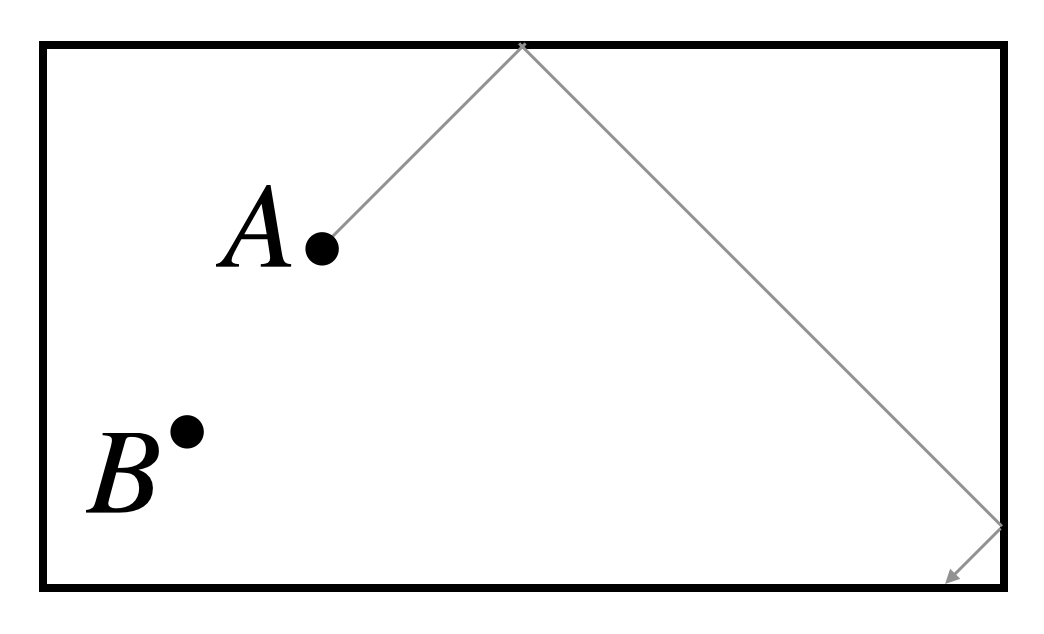Problems
Two ants move along the same straight line and can only move back and forth along it. The first ant moves twice as fast as the second. Where could you place a breadcrumb so that the slower ant reaches it first?
Two ants, Muffy and Chip, start on opposite sides of a circle. Muffy moves twice as fast as Chip, and both can only move along the circle’s edge. Where could a breadcrumb be placed so that they both reach it at the same time?
Two points, \(A\) and \(B\), lie between two lines \(L\) and \(H\). Draw the shortest path from \(A\) to \(B\) that touches \(L\), then \(H\), and finally reaches \(B\).

Ignat is playing pool and places a ball at point \(A\), as shown below. Can he bounce ball \(A\) off a ball placed at position \(B\), if the ball can only bounce off the top and right edges of the pool table?
When a ball bounces off the edge, it does so just like light reflecting in a mirror: the angle at which it hits the edge is the same as the angle at which it bounces away.

A ball \(A\) is placed on the pool table as shown below. The walls are labeled as follows: wall \(1\) is the top wall, wall \(2\) is the right wall, wall \(3\) is the bottom wall, and wall \(4\) is the left wall.
If we hit the ball so that it bounces off the walls labeled \(1\), \(2\), \(3\), and \(4\) —in that order—and then stops rolling just before hitting the next wall, what region of the pool table can the ball reach? If the ball hits a corner, it also stops.
A point \(A\) is placed on the bottom edge of a cylinder, along the rim of the lower circle. Another point \(B\) is placed on the top circle, but opposite to opposite to \(A\), so that \(A\) and \(B\) are as far away as possible from each other.
Find the shortest path along the curved surface of the cylinder that goes from \(A\) to \(B\).
There are some coins in a straight line, all showing heads. You can choose any coin to flip. When you flip one, your friend must flip the coins directly next to it (the ones on its left and right, if there are any). For example: if you flip the first coin, your friend only flips the second coin, and if you flip the second coin, your friend flips the first and third coins.
The question is: no matter how many coins there are, can we always make all of them show tails in the end?
The product of two positive numbers \(a\) and \(b\) is greater than \(100\). Prove that at least one of the numbers is greater than \(10\).
Often in maths we want to prove statements of the form “If A, then B.” For example: “If a number is divisible by \(4\), then it’s even.”
Usually, we prove such statements using something called a direct proof. In the example above, a direct proof would start by imagining we have some number — we don’t know which one — but we know it has the property “divisible by \(4\)”, and then using this information to work out that the number must be even.
However, this kind of direct reasoning can sometimes be tricky. Luckily, there’s another way! The idea is that a statement of the form “If A, then B” means exactly the same thing as “If not \(B\), then not \(A\).”
This second way of writing it is called the contrapositive, and we call “not \(B\)” the negation of \(B\). Here’s an everyday example: “If it rains, then I take my umbrella." is exactly the same as saying “If I don’t take my umbrella, then it’s not raining."
When we use this method in maths, we often say we’re proving by contrapositive: instead of proving “If \(A\) then \(B\)”, we prove “If not \(B\) then not \(A\).” Using this idea, to prove the example above, it would be the same as to prove the statement: ”If a number is not even, then it’s not divisible by \(4\)".
We sometimes write “If \(A\) then \(B\)” as \(A \implies B\), which is pronounced “\(A\) implies \(B\)”. Its contrapositive is: \(\text{not }B \implies \text{not }A.\) This way of thinking often makes a proof much simpler. Let’s see some examples to learn how to use this method.
Write the contrapositive of the statement “If it is sunny outside, then I put on sunscreen and wear sunglasses”